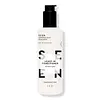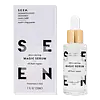What's inside
What's inside
 Key Ingredients
Key Ingredients

No key ingredients
 Benefits
Benefits

 Concerns
Concerns

No concerns
 Ingredients Side-by-side
Ingredients Side-by-side

Water
Skin ConditioningC13-15 Alkane
SolventCetearyl Alcohol
EmollientGlycerin
HumectantSqualane
EmollientBehentrimonium Chloride
PreservativeHydrolyzed Ceratonia Siliqua Seed Extract
Skin ConditioningMoringa Oleifera Seed Extract
Skin ConditioningBisabolol
MaskingZea Mays Starch
AbsorbentPolyquaternium-7
Guar Hydroxypropyltrimonium Chloride
Skin ConditioningTocopherol
AntioxidantDisodium EDTA
Ethylhexylglycerin
Skin ConditioningPotassium Sorbate
PreservativeDisodium Phosphate
BufferingSodium Benzoate
MaskingCitric Acid
BufferingPhenoxyethanol
PreservativeWater, C13-15 Alkane, Cetearyl Alcohol, Glycerin, Squalane, Behentrimonium Chloride, Hydrolyzed Ceratonia Siliqua Seed Extract, Moringa Oleifera Seed Extract, Bisabolol, Zea Mays Starch, Polyquaternium-7, Guar Hydroxypropyltrimonium Chloride, Tocopherol, Disodium EDTA, Ethylhexylglycerin, Potassium Sorbate, Disodium Phosphate, Sodium Benzoate, Citric Acid, Phenoxyethanol
 Reviews
Reviews

Alternatives
Ingredients Explained
These ingredients are found in both products.
Ingredients higher up in an ingredient list are typically present in a larger amount.
C13-15 Alkane is a group of alkanes with 13 to 15 carbon atoms in the alkyl chain.
It is a solvent and texture enhancer. Solvents are used to keep ingredients together in a product. They can help dissolve ingredients to stable bases or help evenly distribute ingredients throughout the product.
Squalane is an emollient that helps the skin hold onto moisture. It's an oily liquid that occurs naturally in certain types of fish and plant oils.
Because squalane boosts hydration in the skin, it also comes with plenty of benefits: it is an antioxidant and can help fight free radicals and skin damage. Squalane is also found to have a detoxifying effect when applied.
Squalane comes from squalene, which occurs naturally within the sebum of our skin. It is one of the oils our skin produces to keep itself hydrated. Squalane is the hydrogenated version of squalene and has a longer shelf life.
Research shows that squalane is non-irritating (even at 100% concentration).
In general, it's a fantastic ingredient. It does a great job at hydrating the skin, and it's suitable for those with sensitive skin.
The source of squalane may impact malassezia / fungal acne. This is because olive oil derived squalane can contain impurities such as fatty acids and plant waxes. Sugarcane derived squalane is recommended for anyone with malassezia concerns.
Is squalane vegan?
This depends on the source. Squalane can be derived from both plants and animals. Most squalane used in skincare comes from plants.
Please note: the source of squalane is only known if disclosed by the brand. We recommend reaching out to the brand if you have any questions about their squalane.
Read more about squalene with an "e".
Is squalane an oil?
Squalane is often called an oil, but it’s technically not; it’s a hydrocarbon, meaning it’s only made of carbon and hydrogen, unlike true oils which are triglycerides made of fatty acids and glycerol.
The term “oil-free” isn’t regulated, so companies can define it however they want. Some exclude all oils, while others just avoid mineral oil or comedogenic oils.
While some people avoid oils thinking they cause breakouts, the right kind of oil (or oil-like ingredient like squalane) can actually help balance and hydrate your skin. It’s worth testing out simple oils or squalane to see what works best for your skin.
Learn more about Squalane